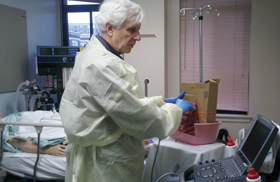Start preparing now for ICD-10's looming requirements
The new code set is much larger and will impact not only office staff but vendors. It's now time to start preparing for the transition, which is closer than you think.
While the next two-and-a-half years seems like plenty of time to transition to the ICD-10 code sets, doctors and their staffs should have already completed their initial planning. The new code set is much larger and will require staff training, negotiations with vendors and, most important, planning to meet the compliance date of Oct. 1, 2013. ACP suggests that practices begin immediately, if they have not already, to develop their transition plans.
The ICD-10 coding system greatly expands the ICD-9 code set, which was developed nearly 30 years ago. The number of diagnosis codes will increase from approximately 13,000 to 68,000. Adopting ICD-10 will require internists to educate clinical and administrative staff on this expanded and more precise coding system.
Art 1 It will also require discussions with any other information technology vendors whose product intersects with ICD-10. There must be software updates, a review of health plan contracts, modification of office superbills and other coding documentation processes, and general implementation of these changes into the office workflow.
Q: How do I begin our practice's transition to ICD-10?
A: During the first quarter of 2009 through the second quarter of 2011, you should have been developing your overall transition plan, including:
- creating an implementation plan with stated transition strategies, goals, tasks, and objectives;
- making your practice/organization's key stakeholders aware of ICD-10 and speaking with them about their own readiness planning; and
- performing impact assessments for your systems, applications, documentation processes, workflow, and policy implications.
You should have also developed budget plans that include all aspects of your practice (consulting, software purchases, staff training, reprinting forms and documents, etc.), and should have prepared for internal testing of these systems.
The next phase of planning will likely overlap somewhat with the first phase. CMS suggests that the second phase take place during the first quarter of 2011 through the second quarter of 2013. During this phase, practices should continue to assess the quality of their medical record documentation, implement any documentation improvement strategies that may be necessary, and monitor the impact of documentation improvement strategies.
Coders should be gaining more familiarity with ICD-10 code sets and coding guidelines and improving their skills. (Intensive coding instruction is not needed at this point.) It will be important to maintain communication with business associates to follow up on their readiness. As your practice moves closer to the effective date, refine the project plan, timeline(s), and budget as necessary. Because caution is always advisable, develop a contingency plan for continuing operations if critical systems issues or other problems occur when the ICD-10 implementation goes live.
Q: It's already the second quarter of 2011, so we're behind schedule in planning. What should we do to catch up?
A: You'll need to set priorities. Separate things that must be started immediately from those that can wait for a short while. Vendor contract negotiations should be on your “immediate” list, for example, because those will take some time to complete. Items such as intensive coder training or document reprinting do not need to be at the top of the priority list right now. Early planning can actually reduce your potential transition costs.
Q: Will all practices and hospitals be required to switch to ICD-10?
A: Yes. ICD-10 is required by the Health Insurance Portability and Accountability Act (HIPAA) for all physicians, providers and entities covered by its rules. Physicians will use only the ICD-10-CM (Clinical Modification) for diagnosis codes. Hospitals will be required to use both components of ICD-10: the procedure code system (ICD-10-PCS) and the diagnosis code set (ICD-10-CM) on inpatient claims. All health care payers are expected to require use of ICD-10 on all claim-related transactions, including those submitted via hard copy or fax.
However, because HIPAA does not apply to property and casualty insurance lines (homeowner's insurance, auto insurance, workers' compensation), it is unclear how claims on those policies, especially those that will cross over to medical insurance, will be coded.
For example, if a physician sees a patient for a work-related injury prior to Oct. 1, 2013, the diagnosis code(s) will be in ICD-9 because all medical claims are coded with ICD-9 for those dates of service, regardless of the policy type. If that claim were to remain in workers' compensation liability, the diagnosis code(s) would presumably remain in ICD-9, because property and casualty insurance does not have to transition to ICD-10.
However, if the injury were investigated and found to be non-work related, those claims would very likely need to be re-coded to ICD-10 and submitted to the patient's health care insurer, which is mandated to transition to ICD-10, instead. Similar scenarios are possible in automotive insurance and homeowner's insurance claims.
Q: I've heard that there's going to be a freeze on the codes. What does that mean?
A: Because the annual ICD-9-CM and ICD-10 code updates make transition planning difficult, many medical specialty societies, vendors, system maintainers, payers, and educators requested a code freeze to allow system updates and testing on a stable code set.
CMS agreed to a partial code freeze; the last regular, annual updates to both ICD-9-CM and ICD-10 will be made on Oct. 1, 2011. On Oct. 1, 2012, there will be only limited code updates to both the ICD-9-CM and ICD-10 code sets to capture new technology and new diseases. On Oct. 1, 2013, there will be only limited code updates to ICD-10 code sets to capture new technology and new diseases. Regular, annual updates to ICD-10 will resume after that.
CMS states very firmly that there will be no delay in implementation, and that it strongly encourages all parties to begin preparing now for the transition.
Q: You advise that we should be talking with our vendors. What questions should we ask?
A: At a minimum, the questions should include these points:
- What is your timeline for readiness and compliance?
- Is the ICD-10 transition included in the upgrade package, or will there be additional fees?
- What support and training will you provide?
- Will your products be able to support both ICD-9 and ICD-10 at the same time, surrounding the Oct. 1, 2013 transition date?
- How long will the upgrade/installation take? What impact can a practice expect it to have on daily operations?
Q: Where can I learn more about ICD-10?
A: The ACP website offers resources to help with your ICD-10 transition planning.
The American Association of Professional Coders offers educational sessions.




